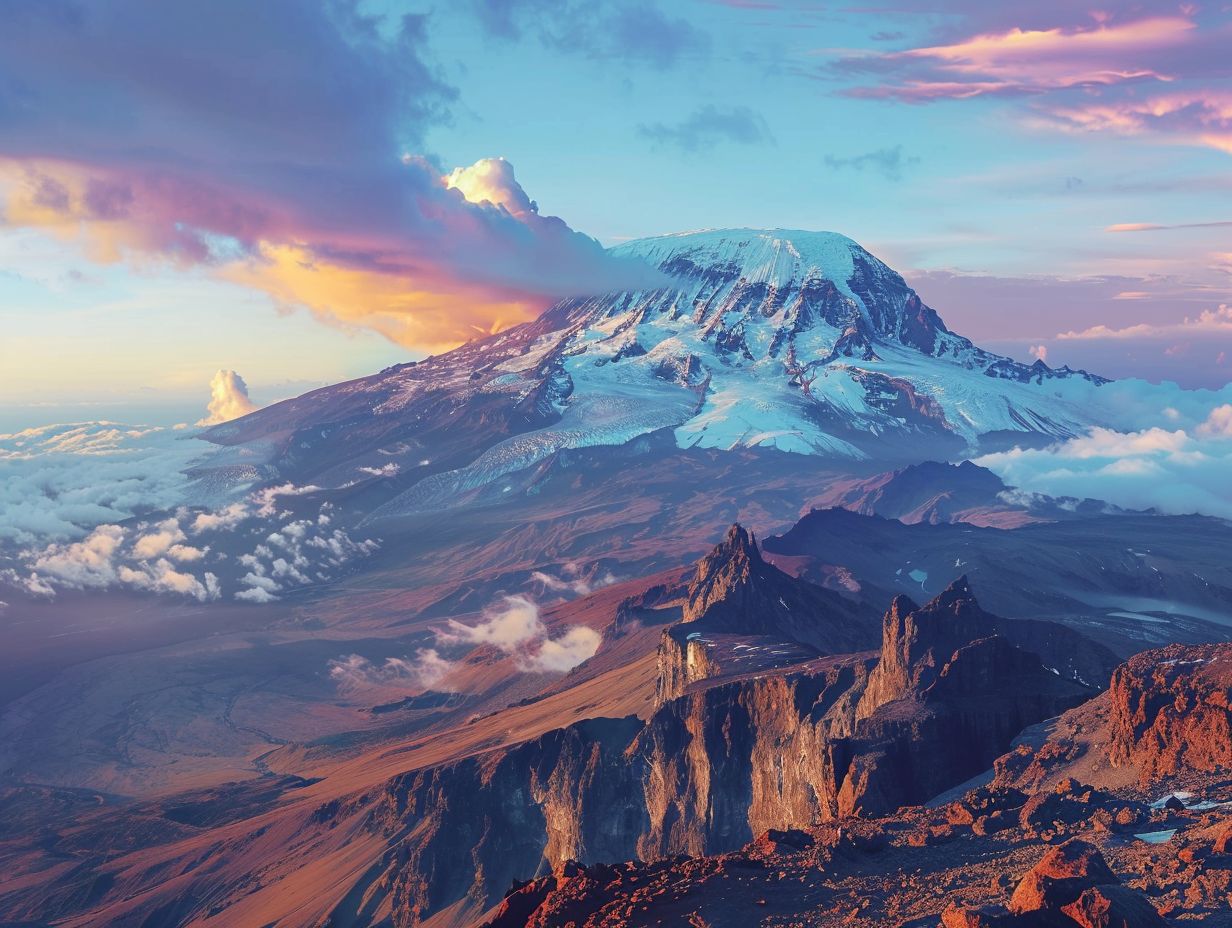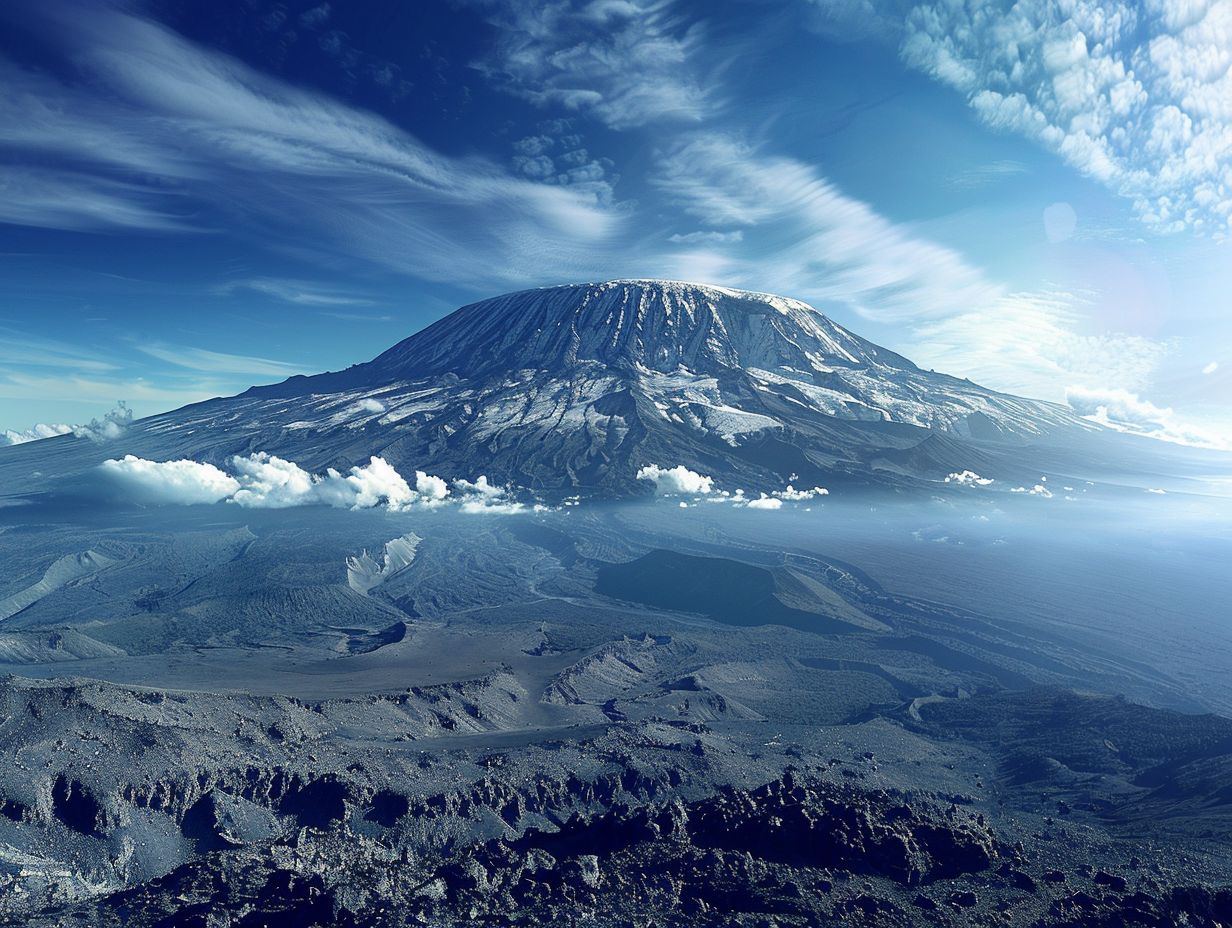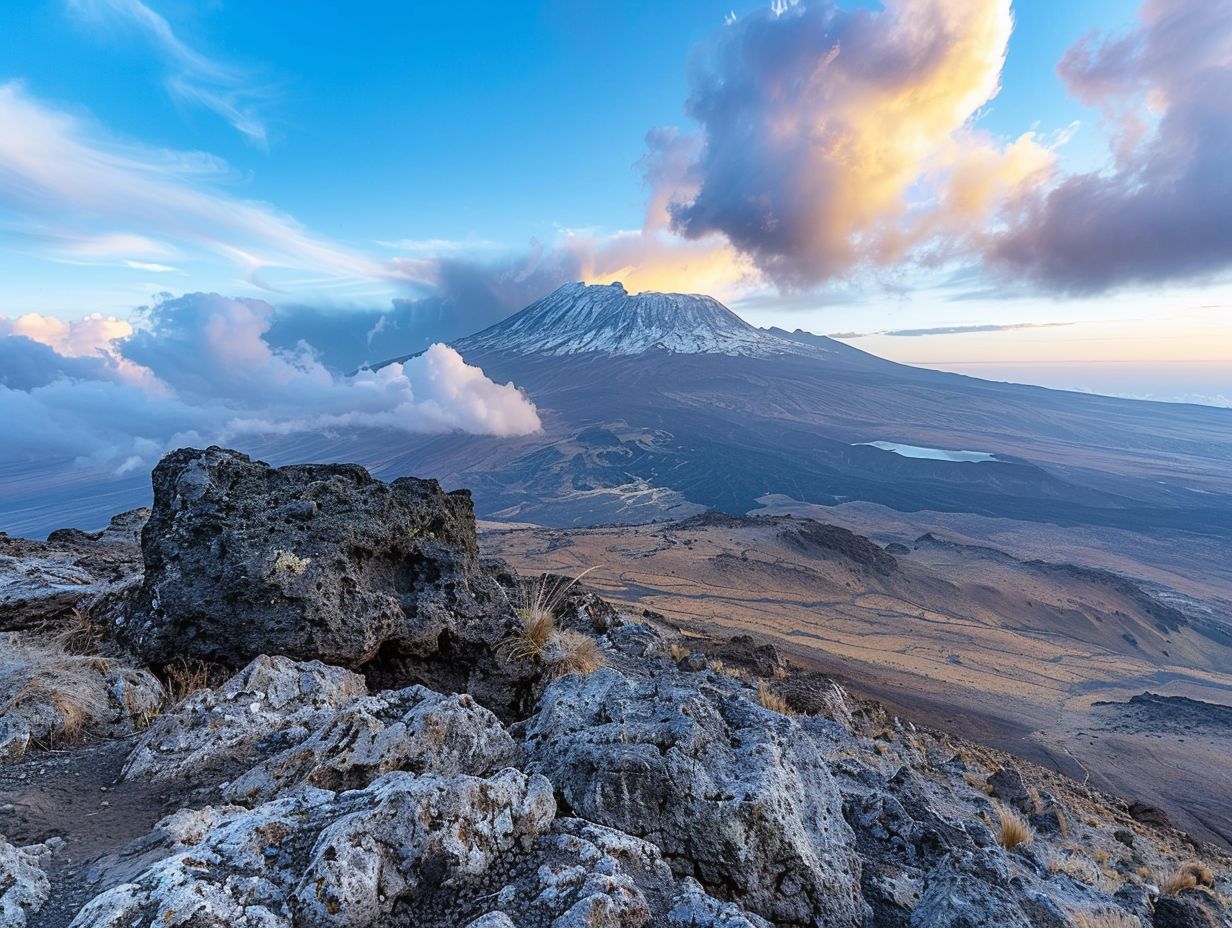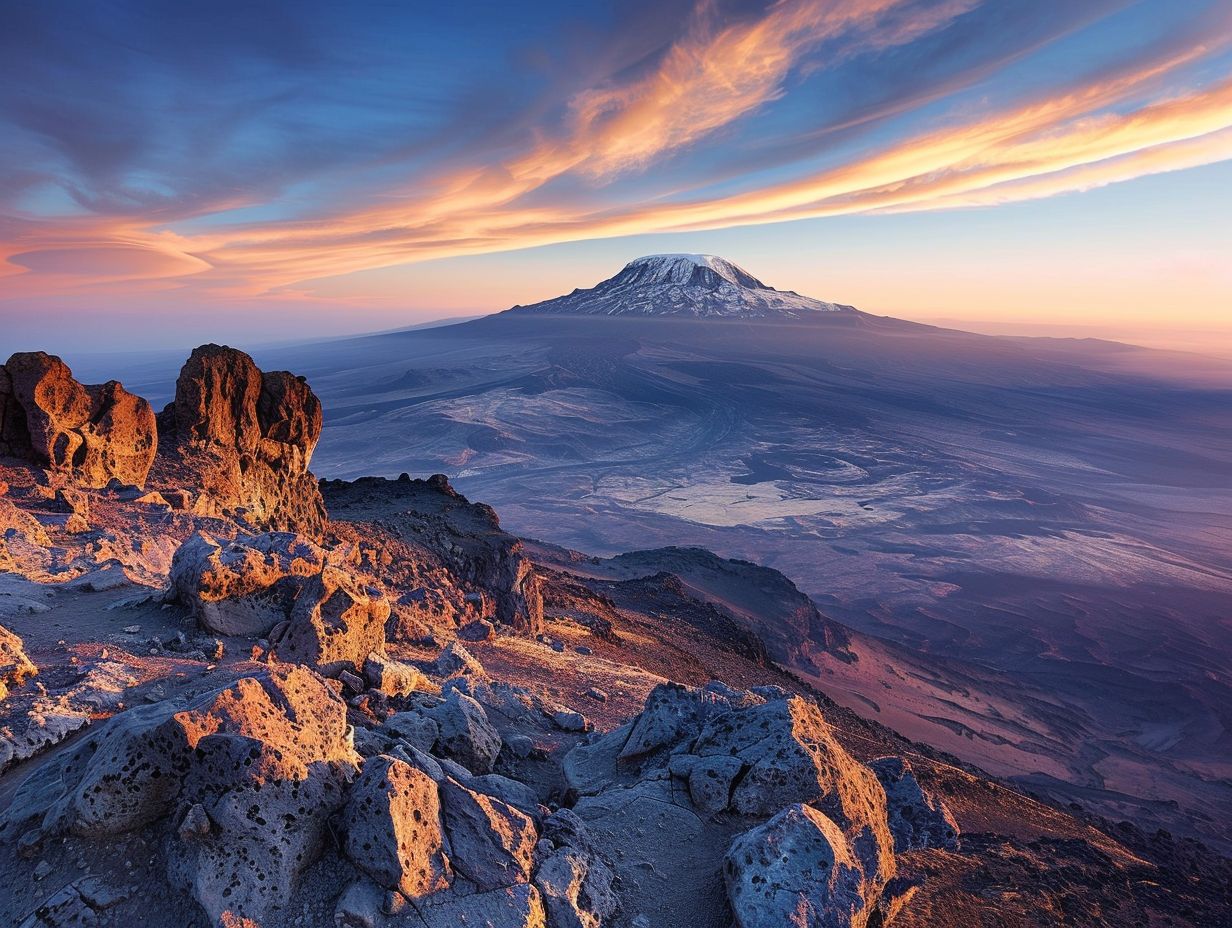
Stella Point Kilimanjaro
If you’ve ever dreamt of conquering the iconic peak of Kilimanjaro, then Stella Point is a destination you’ll want to reach. But what exactly is Stella Point Kilimanjaro, where is it located, and what is the best time to climb it?
In this article, we’ll explore the different routes to Stella Point, the physical requirements needed, the accommodation options available, safety precautions to keep in mind, essential items to pack, challenges you may face, and the ultimate rewards of reaching this stunning summit.
So, get ready to lace up your boots and embark on an unforgettable journey to Stella Point Kilimanjaro!
Key Takeaways:

- Stella Point Kilimanjaro is a popular hiking destination in Tanzania known for its stunning views and challenging terrain.
- Located in the Kilimanjaro National Park, Stella Point can be reached through various routes, including Marangu, Machame, Lemosho, Rongai, and Umbwe.
- The best time to climb Stella Point is during the dry season from July to October, when the weather is more favorable for hiking.
What is Stella Point Kilimanjaro?
Stella Point is a crucial landmark on Mount Kilimanjaro, located at an elevation of 5,756 meters (18,885 feet) on the mountain’s crater rim.
Reaching Stella Point is a pivotal moment for climbers as they near the ultimate goal of reaching the summit. At this point, the breathtaking views of the expansive glaciers below and the sun rising over the vast African plains are truly awe-inspiring. It serves as a significant milestone, marking the final stretch to Uhuru Peak.
Climbers often experience a mix of exhaustion and exhilaration as they make their way along the arduous terrain to reach this spot on the mountain. The sense of achievement that comes with standing at Stella Point is unparalleled, fueling climbers with the determination to continue their ascent to the summit.
Where is Stella Point Located?
Stella Point is situated on Mount Kilimanjaro, the highest peak in Africa and one of the most sought-after summits for climbers worldwide.
Located on the southern slopes of Kilimanjaro National Park, Stella Point is just 459 meters away from the iconic Uhuru Peak, the highest point of the mountain. This proximity makes it a significant milestone for climbers attempting to conquer the summit.
What is the Best Time to Climb Stella Point Kilimanjaro?
The best time to climb Stella Point on Kilimanjaro is during the dry seasons, typically from late June to October and from late December to mid-February, to ensure favorable weather conditions and optimal acclimatization.
During these periods, the weather is relatively stable with clear skies, allowing for breathtaking views of the surrounding landscape and a safer climbing experience. The temperature at altitude can vary significantly, so choosing the right time to ascend is crucial for avoiding extreme cold or heat.
Altitude plays a significant role in trekking, affecting how your body responds to physical exertion and oxygen levels. Setting off during the dry seasons increases the chances of a successful summit, as precipitation and storms are less likely to disrupt your journey.
What are the Different Routes to Reach Stella Point Kilimanjaro?
There are several routes to reach Stella Point on Kilimanjaro, each offering unique landscapes, challenges, and experiences for climbers.
Among the popular trekking options to conquer the majestic Kilimanjaro, the Marangu route stands out as the only one with hut accommodations instead of camping tents, providing a different level of comfort.
The Machame route, known for its picturesque scenery, is favored for its gradual acclimatization opportunities.
On the other hand, the Lemosho route is praised for its scenic beauty and a high success rate for summiting.
Rongai is the only route that ascends from the north, offering a less crowded experience.
The Umbwe route, known for its steep ascent, attracts adventurers seeking a more challenging climb.
-
Marangu Route:
The Marangu Route, also known as the ‘Coca-Cola route,’ is one of the most popular paths for climbers on Kilimanjaro due to its gradual ascent and hut accommodations along the way.
One of the unique characteristics of the Marangu Route is its nickname, the ‘Coca-Cola route,’ which originated from the availability of this popular beverage along the trail. Climbers are drawn to this route for its well-maintained paths, providing a smooth journey through diverse landscapes, including lush rainforests and alpine meadows.
Along the way, trekkers pass through various points of interest, such as the Mandara and Horombo huts, offering cozy shelter and facilities for rest and acclimatization.
-
Machame Route:

The Machame Route, known as the ‘Whiskey route,’ is a challenging and scenic path that provides trekkers with diverse landscapes, from lush rainforests to alpine deserts.
One of the striking features of the Machame Route is its breathtaking views of the glaciers shimmering in the distance as trekkers ascend towards the summit. As you wind your way up the trail, the changing terrain offers a unique experience, with each step bringing you closer to the ultimate goal.
The Machame Route is renowned for its spectacular sunrise views from iconic spots like the Lava Tower and Barranco Wall. Witnessing the sun paint the sky in hues of orange and pink is a surreal moment trekkers cherish.
-
Lemosho Route:
The Lemosho Route is a longer and more remote trek on Kilimanjaro, known for its scenic beauty and high summit success rates, offering climbers a chance to traverse diverse landscapes and reach the southern crater rim.
The allure of the Lemosho Route lies not only in its breathtaking landscapes but also in the sense of camaraderie among climbers facing the challenges together. As trekkers navigate through lush rainforests, alpine meadows, and rocky terrain, they are tested both physically and mentally, forging bonds through shared victories and moments of struggle.
-
Rongai Route:
The Rongai Route on Kilimanjaro is known for its quieter trails and gradual ascent from the northern side of the mountain, offering trekkers a serene trek through Kilimanjaro National Park.
As trekkers embark on this route, they are treated to a diverse landscape that transitions through several ecological zones, from lush rainforest to moorland and alpine desert, finally leading to the glacial summit of Uhuru Peak.
The peaceful ambiance of the Rongai Route allows hikers to truly immerse themselves in the natural beauty of Kilimanjaro without the hustle and bustle of more popular trails. Navigating varying terrain and witnessing panoramic views along the way creates a sense of accomplishment unmatched by any other trek on the mountain.
-
Umbwe Route:
The Umbwe Route is the steepest and most direct path to Kilimanjaro’s summit, attracting experienced climbers seeking a challenging and adventurous ascent guided by skilled mountaineers.
Known for its relentless steepness, the Umbwe Route demands a high level of fitness and determination from climbers, making it one of the toughest routes on the mountain.
Climbers rely heavily on experienced guides to navigate the unforgiving terrain, which includes rocky sections, steep ridges, and challenging ascents that test both physical and mental strength.
Accomplishing the summit via the Umbwe Route is a remarkable feat that rewards climbers with unparalleled views and a sense of unparalleled achievement.
What are the Physical Requirements for Climbing Stella Point Kilimanjaro?
Climbing Stella Point on Kilimanjaro requires excellent physical and mental stamina due to the high altitude, demanding terrain, and the need for prolonged endurance during the ascent.
One of the key factors crucial for a successful climb to Stella Point is proper acclimatization. As climbers ascend the slopes of Kilimanjaro, the body needs time to adjust to the reduced oxygen levels at higher altitudes.
Without adequate acclimatization, climbers risk altitude sickness, which can be debilitating and even dangerous. Training for endurance and strength is essential, as the rugged terrain and steep inclines demand physical fitness.
Mental resilience plays a significant role in overcoming the challenges of high altitude. The mental fortitude to push through fatigue, altitude-induced discomfort, and long hours of hiking is equally important as physical fitness. Developing a positive mindset and mental preparedness is essential for climbers to stay focused and motivated during the arduous journey to Stella Point.
What are the Accommodation Options on the Way to Stella Point Kilimanjaro?
During the ascent to Stella Point on Kilimanjaro, climbers can stay at designated camps like Kibo Huts Camp and Barafu Camp, strategically located at different altitudes to facilitate acclimatization and rest.
- These camps play a crucial role in supporting trekkers during the challenging climb to Stella Point. Kibo Huts Camp, situated at around 4,700 meters, offers a comfortable spot for climbers to recharge and adjust to the altitude.
- Barafu Camp, positioned at approximately 4,600 meters, serves as a vital resting point before the final push to the summit. This strategic placement helps climbers acclimate better to the changing weather conditions and reduced oxygen levels as they progress towards their goal.
What are the Safety Precautions to Keep in Mind when Climbing Stella Point Kilimanjaro?

When climbing towards Stella Point on Kilimanjaro, it is crucial to adhere to safety precautions such as staying hydrated, following the guide’s instructions, and being aware of changing weather conditions to ensure a safe and successful ascent.
Stella Point, located at an altitude of approximately 18,884 feet, poses challenges due to the high elevation and extreme temperatures. Climbers must acclimatize properly to combat altitude sickness and adjust to the decreasing oxygen levels.
Proper acclimatization is key to preventing altitude-related illnesses. Guides play a crucial role in monitoring climbers’ well-being, providing support, and ensuring everyone is moving at a comfortable pace. Being prepared for varying temperatures, which can range from 20 to -20 degrees Celsius, is essential for a successful expedition.
What are the Essential Items to Pack for Climbing Stella Point Kilimanjaro?
For a successful climb to Stella Point on Kilimanjaro, climbers must pack essential items like proper trekking gear, high-altitude clothing, sturdy footwear, hydration supplies, and a first aid kit to ensure preparedness and safety during the expedition.
Climbers should also include sun protection items such as sunglasses, sunscreen, and a hat to shield against the intense sun exposure.
Carrying a headlamp for early morning starts or late-night hikes is crucial.
Portable snacks rich in energy like nuts, energy bars, and dried fruit can provide quick sustenance during the trek.
Navigation tools like a map, compass, or GPS device are essential for staying on track along the intricate route.
A sturdy backpack with sufficient capacity to carry all these items comfortably is vital for a successful climbing experience.
What are the Challenges and Difficulties of Climbing Stella Point Kilimanjaro?
Climbing towards Stella Point on Kilimanjaro presents various challenges such as altitude sickness, extreme weather conditions, steep terrain, and physical exhaustion, testing climbers’ resilience and determination throughout the ascent.
Altitude at this level significantly impacts climbers, leading to symptoms such as nausea, headaches, and fatigue due to decreased oxygen levels in the air. The weather can change rapidly from blazing sun to freezing temperatures, adding a layer of unpredictability to the climb.
The steep terrain demands constant effort, with each step becoming more strenuous as climbers navigate rocky outcrops and loose scree. Glaciers along the route can pose risks from icefalls and crevasses, making the journey even more treacherous.
What are the Rewards of Reaching Stella Point Kilimanjaro?
Reaching Stella Point on Kilimanjaro is a remarkable achievement that offers climbers stunning views, a sense of victory, and the opportunity to witness the breathtaking sunrise spectacle over the African plains, creating unforgettable memories and a deep sense of accomplishment.
Standing at Stella Point, the world seems to unfold beneath your feet, a symphony of colors painting the vast African landscape. As the first rays of sunlight break on the horizon, casting a warm glow over the rugged terrain, a surge of emotion fills your heart with gratitude and awe, a gratifying moment that words cannot capture.
The shared camaraderie among fellow climbers, the silent exchange of nods and smiles, a universal language of triumph and resilience, strengthens the bond forged in the crucible of the climb. You become a part of a legacy, a narrative of human endurance against nature’s formidable forces, leaving an indelible mark on your soul.
What is the Difference between Stella Point and Uhuru Peak?
The key difference between Stella Point and Uhuru Peak on Kilimanjaro lies in their elevations, with Stella Point being the final junction before the ascent to Uhuru Peak, the highest summit on the mountain and the ultimate goal for climbers seeking to conquer Africa’s highest peak.
Reaching Stella Point, situated at approximately 5,685 meters, marks a significant achievement for climbers as it signifies that they have nearly completed the challenging nighttime climb. From Stella Point, the final push to Uhuru Peak, standing at 5,895 meters, involves a steep ascent, often under the mesmerizing blanket of stars.
Upon reaching Uhuru Peak, climbers are not only rewarded with breathtaking panoramic views across the vast plains below but also receive a certificate recognizing their remarkable feat of conquering Kilimanjaro’s highest point.
How Can One Prepare for Climbing Stella Point Kilimanjaro?

Preparing for the climb to Stella Point on Kilimanjaro involves thorough physical training, mental readiness, altitude acclimatization, and familiarization with the terrain, ensuring climbers are adequately equipped to tackle the challenges and demands of the expedition.
Physical training plays a crucial role in preparing the body for the rigorous demands of the trekking journey towards Stella Point.
Acclimatization techniques are essential to help the body adjust to high altitudes and reduce the risk of altitude sickness.
Mental preparedness is equally important as climbers need mental resilience to overcome physical challenges and stay focused during the ascent.
Understanding the terrain is vital to plan the route effectively and navigate through various landscapes encountered during the trekking expedition.
Frequently Asked Questions:
1. What is Stella Point Kilimanjaro?
A: Stella Point Kilimanjaro is a location on Mount Kilimanjaro, the highest mountain in Africa. It is one of the main routes used by hikers to reach the summit.
2. How difficult is the hike to Stella Point Kilimanjaro?
A: The hike to Stella Point Kilimanjaro is considered to be moderately difficult. It involves steep inclines and high altitude, but it is manageable for most physically fit individuals.
3. What is the best time of year to hike to Stella Point Kilimanjaro?
A: The best time to hike to Stella Point Kilimanjaro is during the dry season, which runs from July to October. This is when the weather is most stable and the chances of rain are lower.
4. How long does it take to reach Stella Point Kilimanjaro?
A: The time it takes to reach Stella Point Kilimanjaro depends on the chosen route and the hiker’s pace. On average, it takes 5-7 days to reach the summit, with the final leg to Stella Point taking 4-6 hours.
5. What should I pack for my hike to Stella Point Kilimanjaro?
A: It is important to pack appropriate clothing and gear for your hike to Stella Point Kilimanjaro. This includes layers for changing weather, sturdy hiking boots, and a sleeping bag suitable for sub-zero temperatures.
6. Do I need a guide to hike to Stella Point Kilimanjaro?
A: It is highly recommended to hire a guide for your hike to Stella Point Kilimanjaro. They are knowledgeable about the terrain and can assist with any difficulties that may arise. Additionally, guides are required for some routes by the Kilimanjaro National Park Authority.